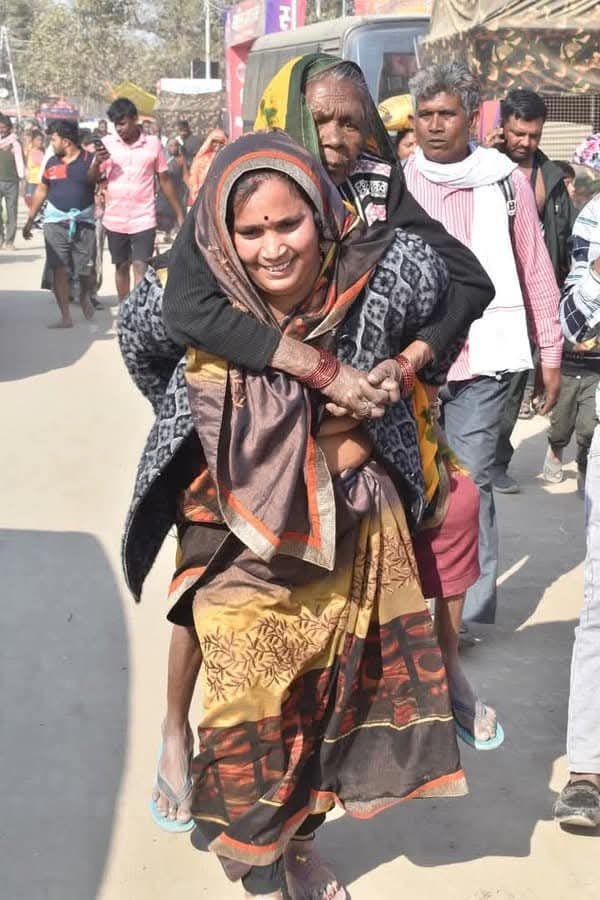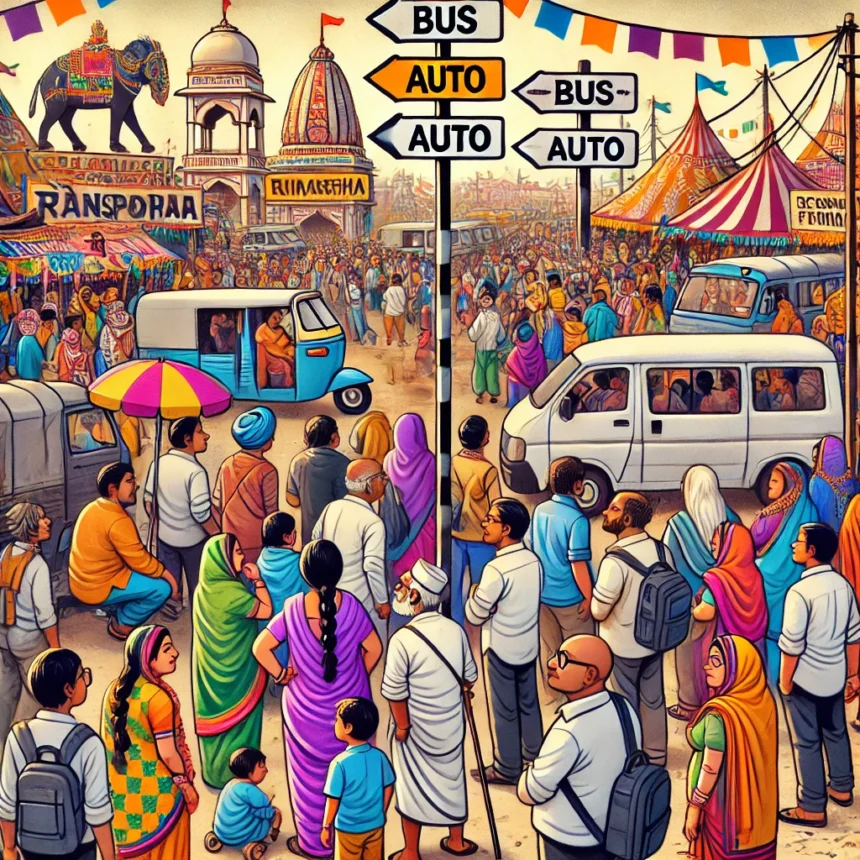Mahakumbh Mela: Meeting Demand-Supply Gap in Local Transport
Analyzing Demand-Supply Gap in Local Transport
As I reflect on my Mahakumbh Mela visit in early February 2025, logistical challenges continue to shape the pilgrim experience, building on our recent discussion of accommodation struggles (Mahakumbha Mela 2025: Tackling Accommodation Challenges). While we’ve explored transportation logistics, accessibility, and lost-and-found solutions, two more pressing issues demand attention are: the demand-supply gap in local transport and the ethical concerns surrounding human-powered loader rickshaws. My own encounters, alongside those of fellow pilgrims, reveal the strain on transport systems and the need for fair, safe alternatives. In this blog, we delve into these challenges, proposing solutions to ensure accessibility, affordability, and ethical transport options for all Mahakumbh Mela 2025 attendees.
Background
Kumbha Mela, held every four years at Prayagraj, Haridwar, Nashik, and Ujjain, is a historic Hindu pilgrimage drawing millions for its spiritual significance. Mahakumbh Mela, its grander version, occurs every 12 years in Prayagraj, with the next event in January-February 2025 at the Ganges-Yamuna-Saraswati confluence. This gathering blends spirituality and culture but faces logistical hurdles like transportation and crowd management, essential for a safe experience.
Our blog series has explored Mahakumbh Mela2025 challenges, drawing from personal experiences and observations. Recent posts include:
Mahakumbha Spiritual Encounters 2025: My Divine Journey – My spiritual journey.
Mahakumbha 2025: Observations, Challenges, and Reflections – Initial logistical challenges.
Mahakumbha 2025 Logistics: Navigating the Transportation Maze – Transportation solutions.
Maha Kumbha 2025: Logistic Vows in Navigation – Accessibility and safety.
Maha Kumbha Sample Site for Lost, Found, and Search Website – Lost-and-found digital solutions.
Maha Kumbha Sample Search Explanation – Reuniting attendees with lost items.
Mahakumbha Mela 2025: Tackling Accommodation Challenges – Accommodation transparency and equity.
Problem and Challenges
The demand for local transport during Mahakumbh Mela 2025 far exceeded supply, creating significant barriers for pilgrims, as I experienced firsthand during my February visit. There was a complete absence of both formal and informal transport means, leaving me/us clueless about what to do as it happened with me. Building on our earlier blog, Mahakumbha 2025 Logistics: Navigating the Transportation Maze, which analyzed transport challenges from a data perspective, this blog focuses on the practical struggles faced by attendees. My journey, detailed in Journey to the Sacred Site of Mahakumbha, underscores the chaos and gaps that impacted accessibility and safety for all pilgrims.
Personal Experience: A Torturous Journey
Arriving at Prayagraj Junction, I found a total absence of local transport to the ghats, particularly Sector 6, where I had booked accommodation. Despite a heavy police presence, there was no guidance on transport availability. I went pillar to post to find buses or autos and remained clueless till I found the bus. This ordeal, as described in Journey to the Sacred Site of Mahakumbha, was a painful experience. The lack of signage and real-time information left me, and many others, stranded and frustrated.
Broader Impacts: A Shared Struggle
[Credit: https://x.com/Ashwani05344501/status/1889186081624744162]
I observed similar struggles among fellow pilgrims, especially families with children and elderly attendees. A group I saw at the bus stand near station, carrying bags and guiding young kids, wandered aimlessly, unable to find transport.

[Credit: https://x.com/i/status/1891030625399755128]
Differently-abled pilgrims faced even greater challenges. A wheelchair user I met, Ramesh, shared his frustration: “There were no accessible vehicles, and the paths were uneven. I missed my evening aarti because I couldn’t reach the ghat.” Similarly, elderly pilgrims like 70-year-old Meena Devi struggled with fatigue. Her son, expressing his concern, lamented, “We’re here for blessings, but the journey is breaking us.”
Stakeholder Perspectives: Voices from the Ground
Local stakeholders also felt the strain. An auto driver, Sanjay, told me, “Demand is high, but traffic blocks us. We can’t serve everyone, and some overcharge out of frustration.” A vendor near the ghats, Priya, added, “Pilgrims can’t reach my stall easily, hurting business. We need more buses and better routes.” These insights highlight the economic and logistical pressures on locals, exacerbating the transport gap.
Ethical and Societal Concerns
The ethical and societal implications of the current transport system at Mahakumbh Mela raise significant concerns. The reliance on human-powered loader rickshaws not only reflects the dire transportation shortages but also highlights deeper societal issues, such as the exploitation of vulnerable populations and the neglect of basic human dignity. These practices, while born out of necessity, contradict the spiritual and communal ethos of Mahakumbh Mela, which emphasizes respect and care for all life.
Our proposed solutions directly address these ethical challenges. By increasing the availability of mechanical transport options like buses and e-rickshaws, and establishing dedicated lanes for efficient movement, we aim to eliminate the need for human-powered transport, thereby reducing the physical burden on individuals who are often from the most disadvantaged sections of society. Additionally, the introduction of transparent fare regulations and the engagement of local stakeholders in planning and execution phases ensures that the economic benefits are fairly distributed, supporting community welfare rather than exploiting it.
Proposed Solutions
Given the extensive challenges outlined, from the complete absence of local transport to the struggles faced by various pilgrims, it’s imperative we turn our attention to actionable solutions. These proposed solutions aim to directly address each identified issue, ensuring a more accessible, affordable, and ethical transportation system for Mahakumbh Mela 2025.
The Need for Tailored Standards
The scale and safety dynamics of Mahakumbh Mela 2025, with its unparalleled footfall of over 500 million attendees over weeks and single-day attendance exceeding 100 million, starkly contrast with events like Hajj, which sees an annual attendance of 2–3 million. This comparison underscores a critical gap: no existing standards can be directly applied to design effective transport solutions for Kumbh due to its unique challenges. Hajj has faced significant safety issues, like the 2015 Mina stampede (over 2,400 deaths) and the 2024 heat-related deaths (1,300 pilgrims), despite continuous safety enhancements. Conversely, Kumbh Mela’s safety incidents are fewer, even with its massive scale, with the 2013 stampede at Allahabad railway station (42 deaths, 45 injuries) during a Maha Kumbh with 100 million attendees over 55 days, and a minor incident in 2025 under investigation for potential sabotage. These events highlight Kumbh’s unique logistical and organizational challenges, crediting the peaceful, law-abiding nature of its attendees for the high safety record amidst these challenges.
This revised paragraph focuses on the key points of comparison:
Scale: Contrasts the attendance figures to emphasize Kumbh’s magnitude.
Safety: Briefly outlines safety incidents at both events to illustrate the difference in scale and management challenges.
Unique Context: Highlights the reasons for Kumbh’s fewer incidents and the need for tailored solutions, acknowledging the public’s role in safety.
This unique context of Mahakumbh Mela 2025, with its immense scale and distinct logistical challenges, necessitates a tailored approach to transport solutions. Building on the lessons learned from past events and the specific issues encountered during this pilgrimage, we now turn to proposing solutions that can bridge the demand-supply gap, ensure ethical transport practices, and enhance the overall experience for all attendees.
Solutions Described
Given the unique challenges and scale of Mahakumbh Mela 2025 the vows I described in my blog Mahakumbha 2025 Logistics: Navigating the Transportation Maze, we propose tailored solutions:
- Volunteer Management Over Police Control: Replace police “control” with volunteer-managed crowd and traffic flow. While police have shown support (e.g., carrying the elderly, aiding navigation), their training leans towards “control” rather than “management,” which is pivotal for Kumbh’s scale.
- Dedicated Transport Lanes: Utilize existing and temporary wide roads for dedicated lanes for public buses (excluding private), autos, e-rickshaws, and bikes. This can expedite movement and is economically viable given the volume of attendees. At the moment most areas are declared no-traffic zones thereby forcing everyone to walk on foot and carry elderly on their backs or hire loader cycle rickshaw that is low speed and inhuman.
- Replication Across Ghats and Central Areas: This model of dedicated transport lanes should be replicated throughout all ghats and from central areas to the ghats, ensuring efficient and streamlined movement of pilgrims across the entire event area. This will facilitate better access to all ritual sites, reducing congestion and enhancing the overall pilgrimage experience.
- Increase Temporary Transport Capacity: Deploy additional buses, shared autos, and e-rickshaws during peak times. Ensure thorough preparation in advance to avoid last-minute inadequacies.
- Transparent Fare Regulation: Fix point-to-point fares transparently to prevent exploitation and ensure affordability.
- Crowd Diversion for Less Congested Areas: Implement strategic traffic control measures to guide pilgrims towards less crowded ghats, thereby reducing congestion at popular spots like Triveni Sangam. This approach will make the pilgrimage experience more pleasing and comforting for visitors. Current practices, such as extensive barricading, often force pilgrims to abandon their plans after enduring lengthy detours, walking for kilometers upon kilometers. By directing crowds effectively, we can enhance comfort and reduce the physical strain on attendees. This would some level of explaining and counselling and everyone would like to have a holy dip at the Sangam Ghat only.
- Dedicated Holding Area at Sangam Ghat: Establish a dedicated holding area at Sangam Ghat. Once this area reaches capacity, pilgrims can be efficiently diverted to alternative ghats, ensuring orderly access to the sacred site and preventing overcrowding, thus maintaining a serene and manageable environment for all attendees.
- Real-Time Traffic and Crowd Monitoring: Utilize any existing real-time monitoring technology to guide traffic flow, enhancing the efficiency of the holy dip and enriching the pilgrim’s experience. This system should aim to prevent the unnecessary designation of “no traffic zones” which often results in pilgrims being forced to walk long distances under the guise of traffic management, a practice frequently self-congratulated by authorities but acts as a big source of pain to every pilgrim.
- Engage Local Stakeholders: From the beginning, partner with local drivers, unions, and vendors for better coordination, offering incentives for fair pricing, extended services, and vigilance against potential sabotage.
- Timely Infrastructure Completion: Learn from 2013’s delays by ensuring all transport and safety infrastructure (temporary hubs, signage, emergency exits) is ready well before the event.
These solutions are based on limited personal experience and available data, acknowledging that one day’s observation does not provide comprehensive knowledge. These proposals are intended as starting points for discussion and require further refinement and collaboration with experts and local stakeholders for effective implementation.
These solutions aim to balance demand and supply, ensuring pilgrims can focus on their spiritual journey without logistical stress. Importantly, by enhancing the availability of local transport, we will automatically eliminate the reliance on informal transport options, such as the loader rickshaws being used for Kumbha local travel. This shift not only addresses the transport gap but also resolves the ethical concerns associated with the use of human-powered loader rickshaws for pilgrim transport.
Conclusion
The demand-supply gap in local transport at Mahakumbh Mela 2025 underscores the need for a more equitable and efficient system. My experience, combined with insights from pilgrims and locals, reveals the financial and emotional toll of these challenges. By implementing targeted solutions, we can enhance accessibility and affordability, aligning with our broader goal of making Mahakumbh Mela inclusive. As we continue exploring logistical concerns, stay tuned for more insights on improving the pilgrimage experience.
Feature Image: Click here to view the image.
Visit our Youtube Channel by clicking here.
Click here to visit the related page on Medium.com
Follow us on our social median handles
Glossary of Terms:
- Kumbha Mela: A massive Hindu pilgrimage held every four years at Prayagraj, Haridwar, Nashik, and Ujjain.
- Mahakumbh: A grander version of the Kumbha Mela, held every 12 years in Prayagraj.
- Ghat: A set of steps leading to a river or lake, often used for bathing or rituals.
- Triveni Sangam: A sacred confluence of three rivers (Ganges, Yamuna, and Saraswati) in Prayagraj.
- Dedicated transport lanes: Designated lanes for specific types of vehicles, such as buses or autos, to streamline traffic flow.
- E-rickshaws: Electric-powered rickshaws used for transportation.
- Loader cycle rickshaws: Cycle rickshaws used for carrying heavy loads not passengers.
- Crowd management: Strategies and techniques used to manage large crowds, ensuring safety and order.
- Real-time traffic monitoring: Systems used to track and manage traffic flow in real-time.
- Volunteer management: Coordination and oversight of volunteers, ensuring effective crowd management and logistical support.
- No-traffic zones: Areas designated as off-limits to vehicles, often implemented during large events to manage crowds.
- Sabotage: Intentional actions or activities aimed at disrupting or damaging the event or its infrastructure.
Top #Tags: #Mahakumbh2025 #KumbhMelaTransport #SpiritualJourney #EthicalTravel #AccessibleIndia



Leave a Reply